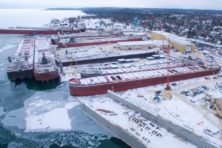A Maritime Tribute
- Share
- Tweet
- Pin
- Share
As part of a Memorial Day tradition that began last year, the Door County Maritime Museum will display a Crossed Oars and Empty Lifejacket tribute to honor fallen veterans. The community is invited to add flowers or other tributes at the base of the display on Memorial Day.
The memorial pays special tribute to four Door County Coast Guardsmen who perished with the U.S. Coast Guard Cutter Escanaba when the ship was sunk by enemy fire during WWII.

The ‘Escanaba’ at port in Grand Haven, Michigan. Photo courtesy of the Door County Maritime Museum.
In the early morning hours of June 13, 1943 Escanaba was escorting a convoy from Narsarssuak, Greenland to St. John’s, Newfoundland when she exploded in a sheet of flame and dense smoke. The cutter sank so quickly that she did not have time to send any distress signals. Rescue vessels arrived within ten minutes but found only two survivors and one body. The remaining crew of 13 officers and 92 men was lost to the explosion or to rapid hypothermia in the frigid waters. The exact cause of the explosion could not be determined at the time, but was commonly attributed to a torpedo fired by one of several U-Boats which were in the area at the time. One-hundred-and-five coast guardsmen perished with the Escanaba including the four crewmen from Door County.
The U.S. Coast Guard Cutter Escanaba was built at the Defoe Shipbuilding Company in Bay City, Michigan in 1932. She was commissioned on November 23, 1932 in Grand Haven, Michigan and quickly became well known throughout the Great Lakes and a beloved part of her home port’s community.
At the outbreak of the Second World War in 1941, Escanaba’s homeport was shifted to Boston, and she was assigned to the Greenland Patrol performing combat escort duty and search and rescue operations in the North Atlantic. In June of 1942 Escanaba was credited with the sinking of two enemy submarines in a single day.
On February 3, 1943, Escanaba gained national notoriety for her participation in the rescue of the survivors of the U.S. Army Transport Dorchester, which had been torpedoed by a German submarine. The rescue was marked by the Escanaba’s historic first use of rescue swimmers clad in survival suits to aid survivors who were too weakened by shock or hypothermia in the icy water to pull themselves up cargo nets or sea ladders to safety. In all, Escanaba plucked 133 living souls from the water that day.


